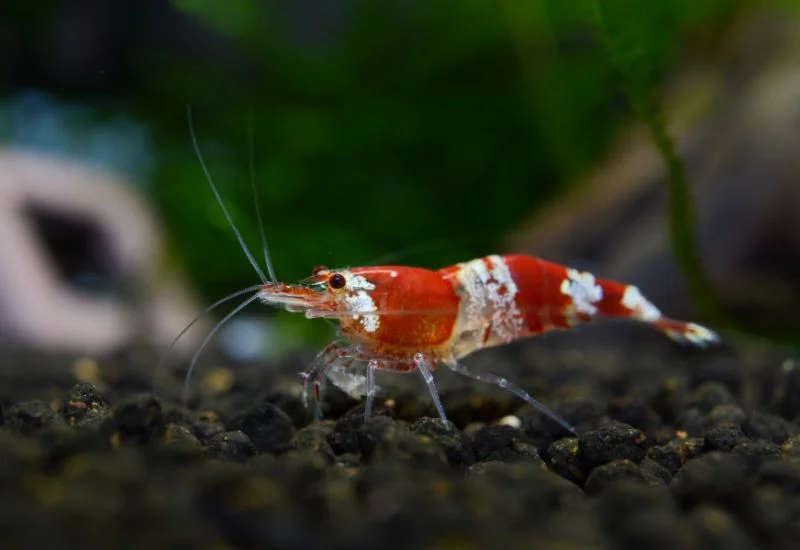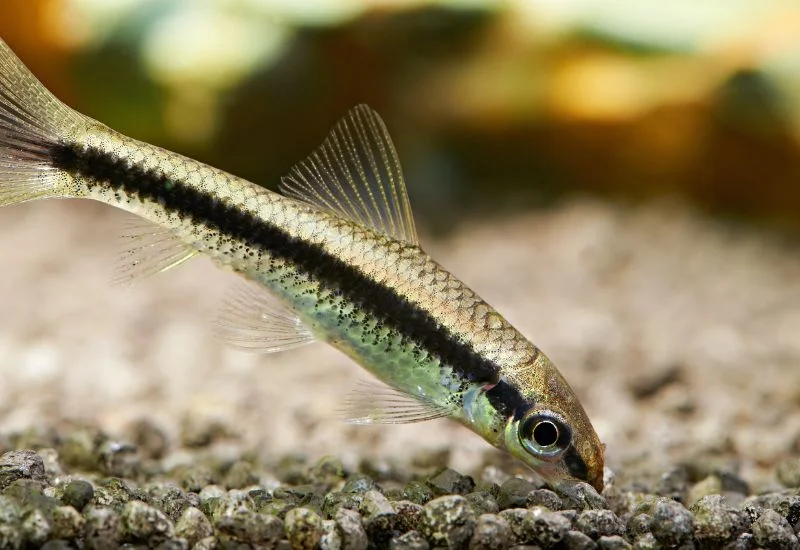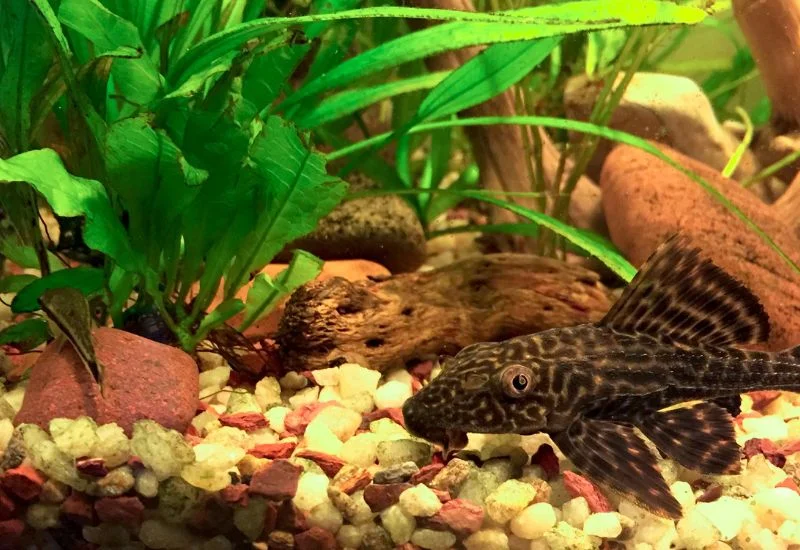A limited amount of algae is not harmful to your tank, but an imbalance of algae can cause several problems.
It can create cloudy water by damaging the water quality, increasing harmful chemicals, and impacting fish health.
The algae eating fish is a natural way to eliminate the algae from your aquarium. Here is the guide on algae eating fish.
Understanding of Algae
Algae are photosynthetic organisms, not true plants, and they produce oxygen through photosynthesis. They make their food through photosynthesis using a cell called chlorophyll. It is a member of the kingdom Protista. The size of the algae can range from microscopic to Micromonas, which can be 200 feet.
Types of Algae
Here is a list of different types of algae:
Brown Algae
Brown algae are a type of algae that can include diatoms among other forms. It can survive in less lighting. It appears in the form of thin mass. It usually appears in new aquariums. It can be gone by itself once the aquarium is fully cycled and filters are mature.
Black Brush Algae
The black brush algae is also known as beard algae. It grows in the color of black, purplish in the form of threads. This slippery algae is hard to remove. The place where the water flow is strong is the perfect place for beard algae.
Blanket Weed Algae
This is the worst type of algae. The color of algae is green. It is in the shape of rough branches and looks like a moss. Blanket weed algae is hard to remove as it does not fall apart like others.
Blue/Green Algae
The blue/green algae is the rapidly-growing cyanobacterium. It can grow faster and cover your tank with green, blue, purplish, or red substances. It can be seen in front of your tank where light hits the most. The causes of this algae are overfeeding and no water change in the aquarium.
Hair Algae
This type of algae is in the form of hair when taken out from the aquarium. The growth of the algae is rapid. It can grow due to too much light, and too much availability of nutrients.
Types of Algae Eating Fish and Invertebrates

Algae Eating Fish
Siamese Algae Eater
They can grow to 6 inches and can live in temperatures from 24° to 26°. The fish not only can eat algae from the rocks, but it will also clear the uneaten food from the tank. The fish are friendly in the neighborhood. You need to watch the tendency to jump. Keep the water level a little so fish cannot jump out.
Chinese Algae Eater
This fish is a type of siamese, but it can grow up to 11 inches. The fish is also known as Gyrinocheilus aymonieri. The fish has a big cup-style mouth through which it attacks glass rocks and other objects in the aquarium. The fish is calm in nature when younger but can be territorial when it grows up. The fish is also known as black algae eating fish. The fish can snack on algae wafers and supplement with raw zucchini or cucumbers.
Reticulated Hillstream Loach
The fish is also known as butterfly hillstream and is famous for algae eating. Most of the diet of this fish is plant-based, but the fish can also eat catfish. If there is not enough algae growth in your tank, you need to provide an additional food source for the fish. The fish can eat sinking wafers, Tubifex, Insect larvae, Blanched vegetables, and Frozen spirulina brine shrimp.
Florida Flagfish
The size of the fish can be 2.5 inches. It is a North American pupfish that can live up to one year. Males are more vibrant than females. The fish is happy to eat algae and has a perfect mouth to nibble away hair algae. Black beard algae and fuzzy algae.
Molly Fish
The black molly is famous for eating brown and green algae. The young mollies also eat cyanobacteria. The size of the fish can be 3 to 5 inches . The adult fish prefers to eat green algae and can also snack on fish flakes.
Rosy Barb
Rosy barb (Pethia conchonius) can eat algae. They have a taste for hair algae, thread algae, or any other fuzzy algae. The size of the fish can be 3 inches and come in different colors. The fish can also eat frozen or freeze-dried food, fish flakes, and live foods like insects, worms, and crustaceans.
Panda Garra
Panda Garra, also known as (Garra flavor) eats algae and biofilms in their natural habitat. And prefer to eat the same in captivity. If there is not enough algae in the tank, the fish can also eat algae wafers or pellets, mosquito larvae, small worms, and even regular fish food. The size of the fish can be 2 to 4 inches. It’s hard to breed them in the tank as they have mating requirements.
Flying Fox
Flying fox also known as Siamese Flying Fox. The fish is famous for its beautiful coloration and huge appetite for green algae. The fish like to stay in a group of six or more. As an adult if there are not enough mates around. It can cause stress to the fish. The length of the fish is 4.7 inches. The fish can also eat frozen food, fish vegetables and algae wafers.
Rubber Lipped Pleco
Rubber-lipped pleco is famous for waiting algae. The pleco algae eater is the largest member of the catfish fish family of suckermouth armored catfishes. The fish is also known as Striped, Blonde, or Bulldog pleco. The size of the fish can be 2 feet. Perfect to live in a medium to large tank.
Bristlenose Plecos
This fish is also known as the bushymouth catfish. The size of the fish can be from 4 to 6 inches. It is a calm fish that is good to keep with other fish. They have sucker mouths, which are best for eating algae. The fish has the appearance of a flat body. The fish can consume green spot algae and diatoms.
Otocinclus Catfish
This South American catfish consists of 20 species. Collectively referred to as “otos”. This fish can be 4 to 5 cm long. The fish like to stay on the bottom of the tank. The small fish can eat from the corner of the tank and have a huge appetite.
Whiptail Catfish
This fish has the special mouth to scrape the algae from the aquarium. Whiptail is a bottom dwelling fish. It can be 8 inches long. The fish can be friendly if they keep them with non-aggressive tank mates. The fish also enjoy eating algae wafers, sinking pellets and blanched vegetables.
Twig Catfish
The fish with spoon teeth is famous for eating algae also known as Farlowella vittata. Twing bristlenose catfish fish can grow to 22.5 cm. The fish can eat algae but not totally depend on it. You can feed algae wafers, vegetables and frozen food. The fish is a good neighbor but cannot be kept with big fish as they are shy.
Algae Eating Snails

Nerite Snail
Many Nerite snails are known for their beautiful tiger stripes. The size of a snail can be 3.8 cm. It can eat algae from the rocks and glass and keep the water clean. They can uneaten the food of fish and dead plants.
Apple Snail
The snail is also known as the golden mystery snail. The size of the snail can be 10 cm. The apple snail is also known as Golden Inca Snail and Yellow Snail. They are friendly in nature and can be kept with other fish. They can not only feed on algae. If their diet is not complete, give them needed supplements.
Malaysian Trumpet Snail
Malaysian trumpet snails can eat algae for hard surfaces. The snail also eats the uneaten fish food, fish flakes, algae wafers and feeder tablets. The size of the snail is 2.5 inches. Aquarium with a lot of live plants is the perfect place for these snails. The plants shed edible material which is good for the health of snails.
Shrimp

Amano Shrimp
The size of the shrimp is 2 inches. They are also known as Yamato Shrimp. They are friendly in nature and can live with other tank mates. Amano shrimp can eat different types of algae. They are more comfortable when staying in a group of six or more.
Cherry Shrimp
The size of these shrimp is 1 to 2 inches. They can perfectly live in small to large tanks. They can eat different types of algae without harming the plants. They can also consume shrimp pellets, sinking pellets, and algae wafers to complete their appetite.
Blue Dream Shrimp
Blue Dream shrimp is a good addition not only to the aesthetic of your aquarium but they keep the tank clean by eating algae. These shrimp are also known as Dream Blue Velvet Shrimp. The size of this shrimp can be 2 inches.
Algae Eater with Betta
Before introducing new fish make sure that your algae eater accepts that fish. The recommendation is to keep betta fish in 30 liters of water.
Here is a list of algae eaters who can stay with betta fish
- Ember tetra
- Cherry shrimp
- Guppies
- Cory catfish
- Whiptail catfish
- Siamese algae eater
- African dwarf frog
- Neon tetra
- Harlequin rasbora
- Flying fox
- Panaqolus maccus
- Endler’s livebearer
Small Algae-Eating Fish

Here is a list of small algae-eating fish
- Siamese algae eater
- Bushymouth catfish
- Oto cat
- Amano shrimp
- Gyrinocheilus aymonieri
- Nerite snails
- Common pleco
- Dwarf suckers
- Hillstream loach
Caring for Algae-Eating Fish

Here is the list of how to take care of algae-eating fish:
Aquarium for Algae Eaters
- The size of the tank depends on the quantity and size of the fish you have
- Fish size of 6 inches needs a 20-gallon tank
- The most enormous algae eaters can need 75-gallon
- Keep the aquarium away from the direct sunlight
Things to Add to the Aquarium
- Add the first layer of gravel about 3 cm
- Fill the tank half with dechlorinated water
- Add thermometer and other important equipment into the tank
- Now it is time to add the decor like plants, rocks, and other objects
- Fill the tank full now with dechlorinated water
Filtration
- Choose the filter according to the fish type and tank size you have
- Follow the manufacturer’s instructions to install the good filter in the tank
Heat and Light for Aquarium
- Check the water temperature before adding your fish to the tank
- Different algae eaters have different preferences for temperature. Do accordingly
- Place a heater near the filter so the warm water can be distributed across the tank
- Set the timer for the light. Much exposure to light can impact the health of the fish.
Put the Algae Eater Into the Tank
- Bring your algae eater home
- Begin by accumulating the fish in new water temperature for 15 minutes
- Add the algae-eating fish to the aquarium
- Try not to add more than three fish at once
- The balance of the tank changes every time you add the new fish
- Monitor the quality of water. Then, you can add more
Keep Them Healthy
- If you notice any of these symptoms, contact the professional
- Loss of appetite
- Fading color
- Abdominal swelling
- Odd swimming pattern
Common Challenges and Solutions

- Algae produce food through photosynthesis. Do not place it in direct sunlight or keep it safe from other light sources. It can cause more growth of algae
- The overgrowth of algae can consume oxygen, which is essential for fish survival. It can put fish under stress
- Overfeeding the fish can increase the amount of chemicals in the water, leading to the overgrowth of algae
- Take the uneaten food out after 5 minutes of providing food
- Install a high-quality filter in the tank
- Add live plants as they consume the same nutrients as algae dose
Conclusion
Algae is the common water based plant that can be seen in every aquarium. The limited amount of algae is not harmful but the overgrowth can cause many problems. It can damage the water quality of water. The change in the temperature and ph of water. Impact on fish health. To remove algae from the tank the option of adding lage eating fish is a natural way to get rid of algae.
There are many types of fish, shrimp and snails that you can add into your tank. They will not only increase the aesthetic of your tank but will keep your tank clean. If there is not enough algae available in the tank you can give them additional food depending on their species.
